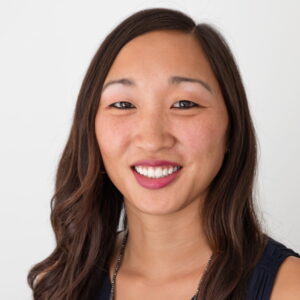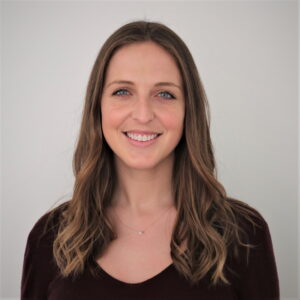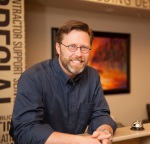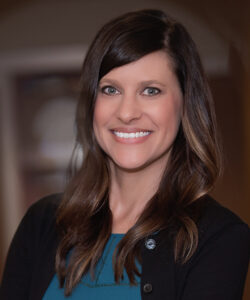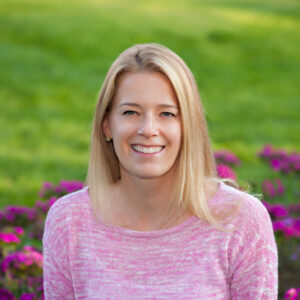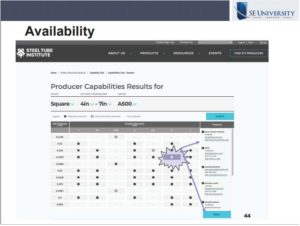24 Nov 2020
Strategies to Address Ponding Loads
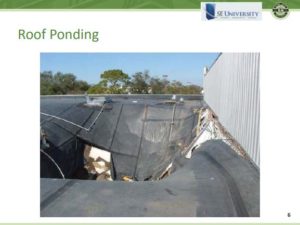 What is the best way to avoid a potentially catastrophic roof collapse due to ponding instability? Once you have determined that ponding could be an issue for your roof design, what is the most efficient way to improve the design to ensure adequate strength and stiffness to resist ponding?
What is the best way to avoid a potentially catastrophic roof collapse due to ponding instability? Once you have determined that ponding could be an issue for your roof design, what is the most efficient way to improve the design to ensure adequate strength and stiffness to resist ponding?
In the November 2020 SE University session, Mark Denavit, PhD, PE, from the University of Tennessee, Knoxville, presented New Methods for Ponding Analysis of Open Web Steel Joist Roofs. Mark’s session reviewed the main roof ponding requirements from design standards and described the limitations of the method of ponding analysis given in Appendix 2 of the AISC Specification. Mark demonstrated how to use the SJI Roof Bay Analysis Tool to determine the stability of a simple roof system and explained the main factors influencing the ponding stability of open web steel joist roofs.
When possible, Mark recommended to first avoid developing ponding loads on roofs by providing adequate slope to a free draining edge. This can be achieved by sloping roof members or using tapered insulation or sloping fill. Mark helpfully noted that parallel chord joists with end supports at different elevations are more economical than providing pitch into the joist top chords.
When ponding must be evaluated, the SJI’s Roof Bay Analysis Tool can be used to quickly and easily determine whether the roof framing is sufficient to resist ponding. If the tool shows that the roof is inadequate, aim to stiffen the roof members to reduce the additional load caused by ponding, or strengthen the roof members to resist the additional load. If possible, you may consider adjusting the shape of the roof to reduce the additional loads from ponding, or you may need to use a combination of these adjustments to reach a stable roof design.
24 Nov 2020
“SEU Speaker Inspires” Organization of the Month: Structural Engineers 2050 Commitment Program SE2050
In October 2020, SE University welcomed Megan Stringer, PE, SE, and Gina Kope, PE, from Holmes Structures, to present Sustaining Structures: Embodied Carbon. Megan and Gina designated SE2050 (https://se2050.org/) for our SEU Speaker Inspires donation for the month.
Megan shared, “The Structural Engineers 2050 Commitment Program (SE 2050) is the U.S. structural engineering profession’s response to getting to net zero embodied carbon by 2050. I have been inspired by my fellow SE 2050 committee members and the volume of work a volunteer group of structural engineers have be able to accomplish in a short amount of time.”
Thank you, Megan and Gina, for helping structural engineers with your SE University session, and for your designation of SE2050 as our SEU Speaker Inspires Organization of the Month!
SE University began the SEU Speaker Inspires program in 2015 as a way to “pay it forward”, enabling our speakers to designate a charity/organization of their choice for SE University to make a donation to help improve our world.
27 Oct 2020
Fly Ash, Slag, or Silica Fume?
When specifying your Concrete Mix Designs, are you aware of the cost implications of pozzolans or supplementary cementitious materials included in your mix? Is fly ash, slag, or silica fume more costly and how much is needed to achieve a mix with the same 28 day strength?
In September 2020, Otto Schwarz, PE, SE, from Ryan Biggs | Clark Davis presented Concrete Mix Design for SE University. Otto reviewed the composition and curing process of structural concrete and explained the function and roles of pozzolans or supplementary cementitious materials and admixtures. He also advised on what to look for in a Concrete Mix Design Review and how to qualitatively predict the relative behavior of a concrete mix design.
Otto showed a visual which explains the Strength Activity Index for different pozzolans and supplementary cementitious materials and relates these to the costs for each material. To hear Otto’s explanation, watch this short video.
As Otto explained, the material costs will obviously vary greatly depending on region, but in most cases, substituting fly ash or slag in place of silica fume will save on the overall cost of the mix. Also, you can see the pound for pound replacement needed for each material to portland cement in order to produce a mix with the same 28 day strength. Engineers should be aware of the cost implications and effectiveness when specifying pozzolans and/or supplementary cementitious materials in their concrete mix designs.
27 Oct 2020
10 Steps for Optimal Email Communication
Email communication has become the primary way engineers communicate with clients, contractors, and consultants. It can become habitual to send off a hasty request or an immediate reply without careful consideration of the language used and whether the topic should be handled via email or whether a phone call may be more appropriate. What standards do you use when deciding what gets addressed via email and how can you use emails appropriately and without unnecessary risk?
In the August 2020 SE University session, Jamie Piercy, from PCIA, presented 7 Deadly Email Sins. Jamie explained some best practices for writing well-crafted emails that are clear, concise and actionable. Jamie also presented examples from actual claims cases and disputes to identify inappropriate text and discussed alternative language in emails. She helped participants to recognize email communication which could create a misunderstanding, exacerbate an issue, or implicate the sender in a claim. Alternate methods of communication were also discussed and recommended in some instances.
Jamie offered 10 steps for best practices when writing emails:
- Know your purpose – Jamie recommends emails be used for the purposes shown below. Any other topics of sensitive nature which may be contentious should be dealt with verbally.
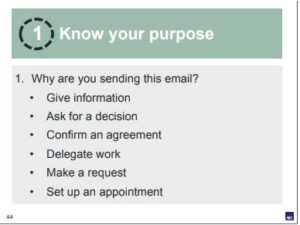
- Strong subject line – Your subject line should clearly state the key message of the email to compel the recipient to open the email. When replying to an email thread, you should create a new message with a new subject line to address the current issue to allow for quick reference in the future..
- Bottom line upfront – Avoid burying any conclusions or recommendations within a lengthy email. The intent should be stated within the first two lines of your email.
- One topic – Keep your emails simple and focused on one issue, decision, request or question.
- Edit – Avoid the use of ‘red flag’ words which can raise the standard of care on projects.
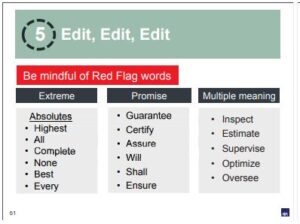
- Concise – Aim for well-organized emails with short sentences that can be scanned quickly.
- Clear Ending – Clearly tell the recipient what they need to do or not do in response to the email.
- Proofread – Checking for spelling and grammar is necessary, but using tools to delay your sent messages or waiting to insert the recipient’s name until the email is complete can prevent incomplete emails from being sent.
- Confidential – ALL EMAILS ARE DISCOVERABLE. Even internal discussions should be treated as though they will be read by the client, and should not contain private, confidential or incriminating information. Care should also be taken to note who is included when you ‘Reply All’ to an email, and whether each person should be included.
- Litmus Test – Jamie suggests asking yourself whether the email may be surprising to the recipient. Should you wait to send the email when you feel less emotional? Would you feel comfortable receiving the email yourself, or delivering it face to face, or reading it aloud on a witness stand? Some sensitive topics should warrant a phone conversation or face to face meeting.
While Jamie focused mainly on email communication, the same rules should be applied to any written form of communication, including text messages and office chat features. While texts and chats can be useful for quick comments, they should be avoided when making changes or revisions on a project or resolving problems. Email should be used to document such critical information. Using these 10 steps to guide your email communication can reduce confusion, enhance your reputation, and prevent costly errors if claims are brought on a project.
In September 2020, SE University welcomed Otto Schwarz, PE, SE, from Ryan Biggs | Clark Davis, to present Concrete Mix Design. Otto designated CREATE Community Studios (https://createcommunitystudios.org/) and Institute for the Musical Arts (www.ima.org) for our SEU Speaker Inspires donations for the month.
CREATE Community Studios exists to ensure the beneficial experience of art-making be affordable and accessible to everyone. Their goal is to use expressive arts as an equalizer across cultural and economic barriers, and for participants to learn how to use art as an expressive medium to increase their general well-being.
The Institute for the Musical Arts in Goshen, MA supports women and girls in music and music-related businesses.
Otto commented, “I’ve suggested both of these local organizations for two reasons. The first is that I believe that the arts and the sciences have equal impact on our lives, and a world without either is lacking. Small, local organizations like these have the most direct and intimate impact on the surrounding communities and the individuals within them. The second is that it is these same small organizations that will have been disproportionally hit by the COVID-19 epidemic and a dollar donated here has a bigger impact than a dollar donated to an organization that has a national supporting audience. As the economy re-adjusts in response to times like these, it is often the arts that suffer first and the most. We should strive to ensure they survive.”
Thank you, Otto, for helping structural engineers with your SE University session, and for your designation of CREATE Community Studios and Institute for the Musical Arts as our SEU Speaker Inspires Organizations of the Month!
SE University began the SEU Speaker Inspires program in 2015 as a way to “pay it forward”, enabling our speakers to designate a charity/organization of their choice for SE University to make a donation to help improve our world.
In August 2020, SE University welcomed Jamie Piercy, from PCIA, to present 7 Deadly Email Sins. Jamie designated Frontline Foods (https://www.frontlinefoods.org/) for our SEU Speaker Inspires donation for the month.
Jamie shared, “In these trying times, our frontline essential workers have worked endlessly supporting our nation through this crisis. These brave individuals are the key to keeping our loved ones healthy. Any piece we can give back as a thank you is so important to me!”
Thank you, Jamie, for helping structural engineers with your SE University session, and for your designation of Frontline Foods as our SEU Speaker Inspires Organization of the Month!
SE University began the SEU Speaker Inspires program in 2015 as a way to “pay it forward”, enabling our speakers to designate a charity/organization of their choice for SE University to make a donation to help improve our world.
21 Sep 2020
Conflict Resolution in the Workplace
Whether you are starting a new job, or have been at the same workplace for many years, conflicts are bound to arise when working in collaboration with other. How we respond to conflicts can influence our job satisfaction, career progression, and affect our reputation within an organization.
I recently found some good tips for managing conflicts in the workplace at Engineering Management Institute’s blog post How to Overcome Conflict with Your Fellow Engineers at Work. The author, Nader Mowlaee, suggests 3 tips to avoid or eliminate workplace disagreements. Click here to learn more about How to Overcome Conflict with Your Fellow Engineers at Work.
Conflict is inevitable but having the right mindset going in can be a game changer. Learning new ways to prevent, confront, and overcome conflicts will certainly be an asset when those disagreements arise.
In July 2020, SE University welcomed Kim Olson, PE, from Steel Tube Institute, to present What Your Fabricator Wishes You Knew About HSS. Kim designated AfterHours Denver (https://afterhoursdenver.org/) for our SEU Speaker Inspires donation for the month.
Kim shared, “AfterHours Denver hands out over 400 lunches, water, socks and communion to the hungry and hurting every week in the park downtown. The smiles on the faces of the people we serve fills my cup while filling their bellies.”
Thank you, Kim, for helping structural engineers with your SE University session, and for your designation of AfterHours Denver as our SEU Speaker Inspires Organization of the Month!
SE University began the SEU Speaker Inspires program in 2015 as a way to “pay it forward”, enabling our speakers to designate a charity/organization of their choice for SE University to make a donation to help improve our world.
28 Aug 2020
Time Management Tips for a Better Life
We’ve all been guilty of feeling like there is not enough time in the day to accomplish all the tasks that life throws at us. But the truth is, we have the same amount of time as everyone else! How do some people manage to accomplish more in their day than the rest of us? If you are like me, I often considered time management to only apply to being on-time and prepared for each of my daily tasks, but the truth is that successful people use time management skills to increase the quality and scope of their life, both at work and at home.
I recently came across a podcast from Craig Jarrow at Time Management Ninja which outlines 10 Small Tips for Big Results in Your Life. They include:
- Catch Up Each Day
- Read for 20 Minutes Each Day
- Work Out
- Learn a New Skill
- Meditate for 10 Minutes
- Keep a Journal
- Always Be Cleaning
- Turn Off the News
- Get Up Earlier
- Start a New Habit
While you may not be able to include all of these tips into your daily regime, Craig Jarrow stressed the importance of consistency in the changes you do make in your life. I particularly identified areas that I need to improve my time management, and that includes eliminating wasted time mindlessly reading the daily news cycle, and also striving to learn some new skills.
By focusing on two small changes, I can be more likely to be consistent in making them a part of my daily routine. Craig offered tips and ways to implement these changes, so head over to his podcast at Time Management Ninja to learn more about how small changes can lead to a big impact in your life.
27 Aug 2020
Finding the Right Size HSS
How can you determine if a specific HSS section is commonly available? Young engineers in particular may not know which sections are most commonly used in their region, and architects often require specific sizes in their drawings for architecturally exposed structural steel. How can engineers avoid the back and forth with contractors who can’t source the sizes shown on the drawings?
In the July 2020 SE University session, Kim Olson, PE, from Steel Tube Institute, presented What Your Fabricator Wishes You Knew About HSS. Kim clarified which HSS column shear and moment connections are most economical and reviewed the information required for cost efficient delegated HSS truss connection design. She also explained tips for discerning availability of HSS shapes in the US and identified the aspects of AESS pertinent to HSS.
Specifying sizes that are readily available can save money by reducing special order items or having to redesign new sizes. STI has explored domestic producers and offers a Producer Capability Tool on their website which can help you locate and specify shapes that are readily available. Click on this link to the STI Capability Tool to locate sizes and material availability and which producers are making various sizes needed for your job.
As you can see, the STI Capability Tool can search various shape sizes and material grades, and provides results to show which shapes are regularly produced, require special order, or are not available domestically. This tool can be handy to preempt change orders and advise architects on which sizes could be used to reduce the costs of jobs using HSS shapes. Additionally, engineers can assist contractors who may have trouble locating certain sizes by providing the applicable producer. Other sizes may be available from international suppliers, however, it is more difficult to ascertain their availability and reliability.

